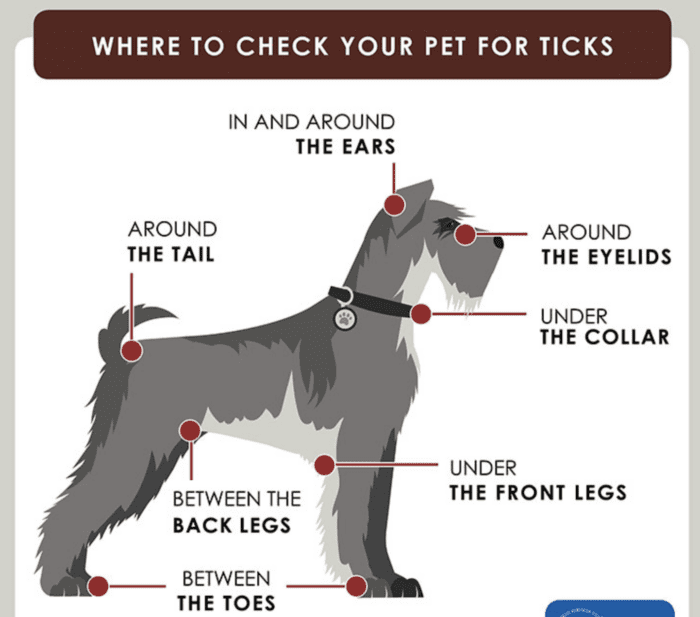Last Updated on July 29, 2024 by Dogs Vets
How to Prevent ticks on your pets: A step by step guide
Tick season is here and it’s time to start preparing your dog for it. There are a few things you can do to help prevent ticks on your pet, and the sooner you do, the better.
Tick bites and the diseases they might transmit are particularly dangerous to dogs.
Vaccines are not available for the majority of the diseases that can be transmitted by ticks to dogs, and these vaccines will not prevent your dog from bringing ticks into your home. It is imperative that you give your dog a tick prevention product due to the aforementioned reasons.
In this blog, we’ll teach you how to get rid of ticks and fleas on dogs, as well as eight ways to keep them protected throughout tick season.
By following our guide, you’ll be able to protect your dog from these pesky pests and prevent any tick-related health problems. So read on and get started!
Here is a step-by-step guide on how to prevent ticks on your pets:
1. **Choose an Effective Tick Prevention Treatment**
Talk to your veterinarian to find the best tick prevention product for your pet. Options include:
– Tick collars – long-lasting, easy to apply, and usually provide flea protection too.
– Spot-on treatments – quick and easy to administer, some kill ticks before they bite.
– Topical sprays – work on contact to kill ticks quickly, allow targeting problem areas.
– Tablets – quick and easy to give, some last up to 3 months.
Always read the label and never use a product intended for another species unless it is specifically approved for both.
## 2. **Regularly Check Your Pet for Ticks**
Inspect your pet daily, especially after being outdoors in grassy or wooded areas. Look closely at the neck, head, ears, feet and between the toes. Use your hands to feel for any bumps that could be ticks.
## 3. **Treat Your Yard to Reduce Ticks**
Ticks thrive in overgrown bushes, tall grass and leaf litter. Mow your lawn short, remove leaf piles, and trim vegetation to eliminate tick habitats. Use an outdoor tick spray in your yard to kill ticks.
## 4. **Properly Remove Any Attached Ticks**
If you find an attached tick, use fine-tipped tweezers to grasp it close to your pet’s skin. Pull upward with steady, even pressure. Avoid twisting or jerking as this can cause the mouthparts to break off. Clean the bite area with antiseptic. If you can’t remove the tick or have concerns, contact your vet.
## 5. **Maintain Your Pet’s Tick Prevention Regimen**
Use tick prevention products year-round, even in winter, as ticks can remain active in milder weather. Treat all pets in the household at the same time to prevent cross-infestation. Wash your pet’s bedding regularly in hot, soapy water.
By following these steps and working closely with your veterinarian, you can help keep your pets safe from ticks and the diseases they carry. Vigilance and consistent prevention are key to a tick-free life for your furry friend.
Discuss the following with your animal doctor:
It could be difficult to identify tick bites on dogs. If you have reason to believe that your canine companion has been afflicted with a disease that is transmitted by ticks, you should keep a watchful eye out for any changes in their demeanor or appetite over the next seven to twenty-one days, or even longer.
The most effective products for protecting your dog from ticks
- To lower the risk that your dog will become unwell as a result of a tick bite even further:
- Always perform daily tick checks on your animals, but be especially vigilant after they have been outside.
- Remove any ticks that you discover on your pet as soon as possible.
- Eliminate as much tick habitat as you can from your yard.
How To Get Rid of Ticks and Fleas on Dogs
Ticks are scary little creatures that can cause a lot of damage to your pet.

Preventing ticks and fleas on your dog can be a challenging task, but not impossible. Here are a few tips to help you get started:
By following these simple steps, you can prevent ticks from infesting your dog and causing them any harm. Remember to keep your dog tick-free every season by doing the following:
– Ticks are tiny parasitic creatures that feed on blood.
– Get rid of ticks and fleas on your dog before they infest them.
– Protect your dog from ticks by using tick prevention products.
– Check your dog for ticks regularly and remove them if found.
– They love to live in warm and moist environments, which is why they’re common on dogs.
– Fleas can also be a problem, as they spread diseases like Lyme disease and sarcoptic mange.
– To get rid of ticks and fleas on your pet, start by taking them for a walk outside regularly in detested areas where these pests are known to reside.
Removal of Ticks on Dogs
Ticks and fleas can be a real nuisance for dog owners. They can transmit disease to your pet, and sometimes it’s hard to get rid of them completely.
The best way to prevent ticks and fleas from spreading is by removing them as soon as possible.
Rapid removal is the key – using a tick remover specifically designed for dogs will do the job quickly and safely. And make sure you keep your dog groomed at all times so they’re free from ticks and fleas!
Removal of Fleas on Dogs
There are a few effective ways to remove fleas on dogs, starting with thorough washing. After the dog is washed, apply a topical treatment to tick-prone areas such as the neck, behind the ears and groin.
If ticks are found outdoors, use tick collars or spray treatments to protect your pet. Flea season is short but it’s important not to let them get out of hand!

Medications for Fleas and Ticks on Dogs
There are various medications available to treat fleas and ticks on dogs.
Flea collars, topical sprays or oral tablets can be used to treatfleas. Ticks can be removed by using a tick remover or DEET-containing insect repellent on the skin.
If ticks are found after treatment, keep them isolated and away from other animals until they have completely healed
Shampoos and Sprays for Fleas and Ticks on Dogs
Flea and tick shampoo are a great way to get rid of fleas and ticks on your dog. They’re also effective in keeping their environment clean, so you can avoid getting sick from these pesky pests.
To use the shampoo, apply it to the animal’s entire body, paying special attention to their heads, necks and underarms.
For best results, repeat the process every few days until the infestation is eliminated.
Make sure to apply tick or flea repellent lotion directly onto their skin before leaving them outside for long periods of time – this will help keep them protected against ticks and fleas while they’re out playing!
How To Get Rid of Fleas and Ticks in Your Home
If you’ve been noticing an increase in the number of ticks on your pet, you’re not alone. tick populations have been on the rise across the US, and they’re not happy about it.
Tick-borne diseases like Lyme disease are on the rise, and they can be quite dangerous for both you and your pet.
To prevent ticks from taking up residence in your home, start by washing your pet regularly – using hot water and soap – and make sure to check all their areas for ticks.
If you do find any, remove them immediately. In addition, make sure to keep your yard well-maintained and tick-free, by regularly washing your pet and checking for ticks daily.
How To Prevent Fleas and Ticks on Dogs
There’s no way to stop ticks from infesting your pet, but prevention is the best medicine. Make sure to take these important steps to protect your dog from Fleas and Ticks:
1. Keep your dog well groomed – this will help reduce the number of bugs on him/her.
2. Use a tick repellent that works specifically for dogs – choose one that’s safe, effective, and long-lasting.
3. Check your pet regularly for ticks and fleas – make sure to remove them as soon as you spot them!
Treat Your Yard for Ticks
Tick season is upon us, and if you’re like many pet owners, you’re worried about ticks on your furry friend.
Luckily, tick prevention is easy and can be done on your own. Here are four tips to keep your pet safe from ticks this season:
1. Ticks are common in the summertime, and if left untreated, they can spread Lyme disease to your pet.
2. There are many different ways to treat your yard for ticks – choose the one that is easiest for you.
3. Keep an eye out for signs of tick infestation, like changes in behavior or unusual scratches or bites on your pet.
4. If you think your pet may have been infected with Lyme disease, consult a veterinarian as soon as possible!
Choose a Tick Treatment Plan for Your Dog
Preventing tick-borne diseases is essential for both you and your dog. Ticks are common in the summertime, and they can transmit a number of diseases to your dog.
There are a few different tick treatments available, so it’s important to find one that works best for you and your pet.
For example, tick prevention products that use permethrin can be effective against both ticks and fleas.
However, be sure to follow the instructions on the product label carefully to avoid any adverse effects.
If you spot a tick after treatment, be sure to remove it quickly using a tick removal tool. Finally, be sure to keep an eye out for ticks after treatment – they may be hiding in inaccessible places!
What I Do When I My Dogs Need Extra Protection from Ticks
Tick season is upon us, and it’s important to be proactive in preventing ticks from attaching to your pet. Here are four steps that will help keep your pet tick-free:
1. Keep your pet vaccinated against Lyme and other tick-borne diseases.
2. Apply a topical Tick Salve or Cream to all areas of the body that are likely to be exposed to ticks, such as the neck, back, tail, ears, and paws.
3. Make sure your pet is groomed regularly so they don’t accumulate ticks in their fur.
4. Check them for ticks daily when you’re outside – if you find any on your pet, remove them immediately with a tick remover likeousing agent or tweezers.
What To Do If You Find a Tick Attached To Your Dog
Tick season is upon us, and that means it’s time to get tick-prepared.
There are a few things you can do to prevent ticks on your pets, starting with prevention.
Start by gently removing the tick with a thin hook or snap tool. If the tick is embedded in the skin, slowly pull it out while applying pressure to the area.
If necessary, get help from a vet to remove the tick and treat any infection that may arise. Do not attempt to remove ticks yourself – this can lead to accidental puncture wounds or even death of the tick!
How you can best protect your dog from ticks
Tick season is upon us! Although most people think of ticks as a nuisance, they are in fact a major health risk for both human and animal populations.
Lyme disease, for example, is a serious infection caused by ticks, and can be extremely debilitating if not treated promptly.
To help prevent tick-related health complications, read on for a step-by-step guide on how to best protect your dog from ticks.
- First and foremost, check your dog’s coat regularly for ticks – even if they appear to be tick-free.
- If you do find a tick on your dog, remove it as quickly as possible using a tick removal tool. If your dog does get bitten by a tick, seek medical help as soon as possible.
- Do not try to remove the tick yourself – this could lead to complications like Lyme disease or anaplasmosis. Remember, tick season is here, so be vigilant and keep your pet safe!
7 Ways to Prevent Ticks on Your Dog
It’s important to keep your pet tick-free, especially if you live in an area with high tick populations. To do this, follow these 8 steps:
1. Always check your pet for ticks after being outside in the yard or woods.
2. Remove ticks as soon as you see them, using a tick remover like Tweezerman or Orkin.
3. Don’t forget to check your dog’s ears, tails, and inside of his mouth – these are all places where ticks can hide.
4. Make sure to give your dog monthly doses of flea/tick prevention medications if he lives in an area with high tick populations.
5. Keep your carpets vacuumed regularly to help prevent ticks from breeding indoors.
6. Check your child for ticks after playing in the yard, and remove them if found.
7. Teach your children the importance of tick prevention and how to check their pets for ticks.
Other Products for Fleas and Ticks on Dogs
There are various products available on the market that can be used to get rid of ticks and fleas on your dog.
Make sure you read the label carefully before using any product, as some may contain harmful chemicals that could harm your pet.
It is important to apply the product as directed and keep a close eye on your dog for any signs of distress or infection.
It is also crucial to keep your yard clean and free from weeds and grass that can serve as havens for these pesky insects.
Conclusion
Do you have a dog or cat? If so, you know that they’re constantly outdoors playing and running around. This can be a dangerous time for them, as ticks can be a real problem.
In this helpful guide, we’ll be teaching you how to prevent ticks on your pets.
Keep in mind that tick prevention begins by educating yourself on the dangers of ticks and how to prevent them from attaching to your pet.
Always check your pet for ticks after spending time outdoors and remove any that are found.
Tick repellent products can also help prevent tick attachment. But the best way to avoid tick problems altogether is to keep an eye out for suspicious looking critters while they’re playing in the yard or park.
So, are you ready to prevent tick problems on your pet? Let’s get started!
Frequently Asked Questions
How do I keep ticks off my dog naturally?
There are a few things that you can do to keep ticks off of your dog naturally.
1. Treating your pet for ticks as soon as you detect them will help in preventing an infection.
2. Use tick repellents and insecticides on pets but make sure to read the instructions carefully before applying them.
3. Combats ticks by regularly grooming your pet – remove all of their excess hair, dirt and dried sweat from their coat.
4. Make sure your dog is vaccinated against Lyme and other tick-borne diseases. This will help to protect them from exposure to these disease-carrying organisms.
5. Always check your dog for ticks after walks, during early morning and evening hours, when the weather is damp or cool, and around bushes or tall grass.
6. If you find a tick on your dog, remove it as quickly as possible using a tick remover specifically made for pets such as Reepicheck Tick Remover for Dogs.
7. Finally, keep your dog flea-free by regularly administering flea prevention medication.
What kills ticks on dogs immediately?
To kill ticks on dogs immediately, spray them with a tick repellent made of 10% DEET, 90% water, and 1 or 2 drops of lavender oil.
Tick collars that use organic vapor technology give your dog protection from ticks for up to 12-hours per day.
If you live in an area where ticks are common, consider getting your pet vaccinated against Lyme disease every year.
Are Indian dog ticks dangerous?
Indian Dog ticks are found all over the United States, including in states like Texas and Florida.
Lyme disease is a tick-borne disease that can be deadly in humans if not treated promptly.
It is important to be aware of their presence and take appropriate measures to avoid them, including checking your pet frequently for lumps or bumps.
Avoiding tall grasses and leafy areas where ticks may hide, using a tick collar that stops biting dogs from pulling ticks off their bodies, and keeping your yard free of weeds that might serve as nesting grounds for these pests.
How can I avoid huge ticks from getting into my dog?
One way to avoid ticks on your dog is by using tick collars. Tick collars are available for both dogs and cats, and emit an irritating sound that will make them run away.
Collars come in all shapes and sizes, and many also have a built-in GPS tracker so you can monitor where your pet goes.
Another way to keep ticks off your pet is by regularly vaccinating them against Lyme Disease.
Lyme disease is a tick-borne disease that can be quite serious for dogs and cats. By getting your pet vaccinated, you’re helping to protect them from this potentially debilitating illness.
What is the safest flea and tick shampoo for dogs?
If you’re looking for a safe and effective flea and tick shampoo that can also protect your dog from ticks, then consider trying Revolution Flea & Tick shampoo.
This shampoo has an EPA (Eco-Friendly) rating, meaning that it’s environmentally friendly and safe to use on your pet. Plus, it kills ticks on contact, so you can rest assured that your dog is protected from these pesky pests.
Sources:
https://www.naturalfarmpet.com
https://ccspca.com
https://www.wikihow.com
Facts Check
We hope you enjoyed this article… What are your thoughts?
We strive to provide the latest valuable information for pet lovers with accuracy and fairness. If you would like to add to this post or advertise with us, don’t hesitate reach us. If you see something that doesn’t look right, contact us!

















